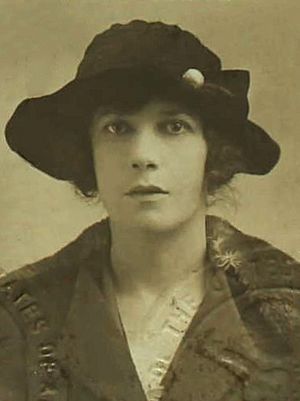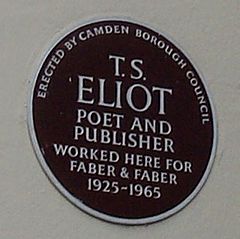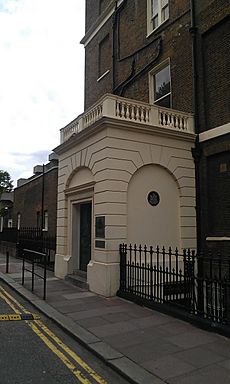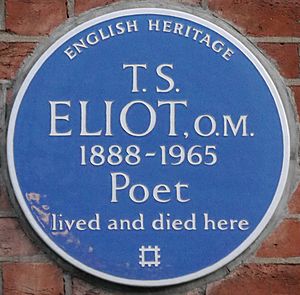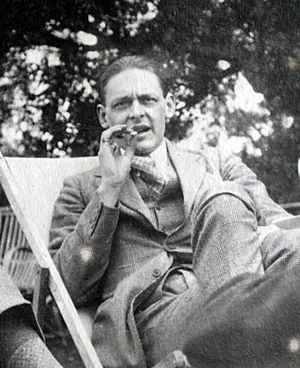T. S. Eliot facts for kids
Quick facts for kids
T. S. Eliot
|
|
|---|---|

Eliot in 1934 by Lady Ottoline Morrell
|
|
| Born | Thomas Stearns Eliot 26 September 1888 St. Louis, Missouri, US |
| Died | 4 January 1965 (aged 76) London, England |
| Occupation |
|
| Citizenship | American (1888–1927) British (1927–1965) |
| Education | Harvard University (AB, AM, PhD candidate) Merton College, Oxford |
| Period | 1905–1965 |
| Literary movement | Modernism |
| Notable works | "The Love Song of J. Alfred Prufrock" (1915) The Waste Land (1922) Four Quartets (1943) Murder in the Cathedral (1935) |
| Notable awards |
|
| Spouse |
Vivienne Haigh-Wood
(m. 1915; sep. 1932)Esmé Valerie Fletcher
(m. 1957) |
| Parents | Henry Ware Eliot Charlotte Champe Stearns |
| Relatives | Eliot family |
| Signature | |
Thomas Stearns Eliot (September 26, 1888 – January 4, 1965) was a very important poet, essay writer, and playwright. He also worked as a publisher and literary critic. Many people think he was one of the greatest poets of the 1900s. He was a key figure in a style of writing called Modernism.
Eliot was born in St. Louis, Missouri, in the United States. His family was well-known. In 1914, when he was 25, he moved to England. He stayed there, worked, and got married. In 1927, at age 39, he became a British citizen. He then gave up his American citizenship.
Eliot first became famous for his poem "The Love Song of J. Alfred Prufrock" in 1915. People thought it was very unusual at the time. Later, he wrote other famous poems like The Waste Land (1922) and Four Quartets (1943). He also wrote seven plays, including Murder in the Cathedral (1935). In 1948, he won the Nobel Prize in Literature. He received it for his amazing and new contributions to poetry.
Contents
About T. S. Eliot's Life
His Early Life and Schooling
The Eliots were a well-known family with roots in England and New England. Eliot's grandfather, William Greenleaf Eliot, moved to St. Louis, Missouri. There, he started a Unitarian church. Eliot's father, Henry Ware Eliot, was a successful businessman. His mother, Charlotte Champe Stearns, wrote poetry and was a social worker. T. S. Eliot was the youngest of six children. His family and friends called him Tom.
Eliot loved reading from a young age. He had some health issues as a child, like a double inguinal hernia. This meant he couldn't play many sports or socialize much with other kids. Because he was often alone, he spent a lot of time reading. He loved books about adventure and the Wild West. He also enjoyed Mark Twain's The Adventures of Tom Sawyer.
Eliot felt that St. Louis greatly influenced his writing. He said that growing up near the Mississippi River left a deep mark on him. He felt lucky to be born there, rather than in bigger cities like Boston or London.
From 1898 to 1905, Eliot went to Smith Academy. There, he studied Latin, Ancient Greek, French, and German. He started writing poetry at 14. His first published poem was "A Fable For Feasters" in 1905. He also wrote three short stories that year. One story, "The Man Who Was King," was inspired by his visit to the Igorot Village at the 1904 World's Fair in St. Louis.
After Smith Academy, Eliot spent a year at Milton Academy in Massachusetts. He then went to Harvard College from 1906 to 1909. He earned a Bachelor of Arts degree in 1909 and a Master of Arts in English literature in 1910. At Harvard, he discovered French Symbolist poets like Jules Laforgue. He also became good friends with the writer Conrad Aiken.
From 1910 to 1911, Eliot studied philosophy in Paris at the Sorbonne. He returned to Harvard from 1911 to 1914 to study Indian philosophy and Sanskrit. In 1914, he received a scholarship to Merton College, Oxford, in England. He planned to study in Germany, but World War I started, so he went to Oxford instead.
Eliot didn't enjoy university life in Oxford much. He spent a lot of time in London. There, he met the important American writer Ezra Pound. Pound quickly saw Eliot's talent and helped him meet other writers and artists. This was very important for Eliot's early career as a poet. Eliot left Oxford after a year. In 1915, he taught English at Birkbeck, University of London. He finished his doctoral paper for Harvard in 1916 but never went back for the final exam.
His Marriages
Before leaving the US, Eliot had told Emily Hale he loved her. They wrote letters between 1914 and 1915 but did not meet again until 1927. In 1915, Eliot, then 26, met Vivienne Haigh-Wood. They married on June 26, 1915.
After a short visit to his family in the US, Eliot returned to London. He took teaching jobs and worked at Lloyds Bank in London starting in 1917.
His marriage to Vivienne was difficult. Vivienne had many health problems, including fatigue, insomnia, and migraines. She also faced mental health challenges. Because of her health, she was often sent away for long periods to get better. Over time, Eliot grew distant from her. Both Eliots were often unwell, which made their home life challenging for visitors.
The couple formally separated in 1933. In 1938, Vivienne's brother arranged for her to live in a special care facility. She stayed there until she died in 1947. Eliot was still her husband legally, but he never visited her. When he heard she had died, he was very upset.
Their relationship was later made into a play and a film called Tom & Viv. Eliot later wrote that he felt he married Vivienne because he wanted to stay in England. He believed she thought she could help him as a poet by keeping him there. He said the marriage brought her no happiness, but for him, it led to the state of mind that produced The Waste Land.
From 1933 to 1946, Eliot had a close friendship with Emily Hale. Eliot later destroyed her letters to him. Hale donated Eliot's letters to Princeton University, where they were kept private until 2020.
In 1957, at age 68, Eliot married Esmé Valerie Fletcher, who was 30. Valerie had been his secretary at Faber and Faber since 1949. They kept their wedding a secret. The ceremony was very small, with only Valerie's parents present. Eliot did not have children with either of his wives. After Eliot's death, Valerie worked to preserve his writings and legacy. She died in 2012.
Working in Publishing
After leaving Oxford, Eliot worked as a schoolteacher. He taught French and Latin at Highgate School and the Royal Grammar School, High Wycombe. He also wrote book reviews and gave lectures. In 1917, he started working at Lloyds Bank in London, dealing with foreign accounts. During this time, he met famous writers like James Joyce and Wyndham Lewis.
In 1925, Eliot left the bank to join the publishing company Faber and Gwyer. This company later became Faber and Faber. He worked there for the rest of his career. As a director, he helped publish many important English poets, including W. H. Auden and Ted Hughes.
Becoming British and His Faith
On June 29, 1927, Eliot changed his religion from Unitarianism to Anglicanism. In November of that year, he became a British citizen. This meant he gave up his United States citizenship.
He became a churchwarden (a church official) at his local church in London. He described himself as "classicist in literature, royalist in politics, and anglo-catholic in religion." This meant he liked traditional styles in writing, supported the monarchy, and followed a specific branch of the Anglican Church.
Eliot later said his religious views combined "a Catholic cast of mind, a Calvinist heritage, and a Puritanical temperament." He also had broader spiritual interests. One of his biographers, Peter Ackroyd, said Eliot's conversion gave him a sense of peace and connected him more deeply to English culture.
Death and Special Honors
T. S. Eliot died from emphysema at his home in London on January 4, 1965. He was 76 years old. His body was cremated. As he wished, his ashes were taken to St Michael and All Angels' Church, East Coker. This village in Somerset, England, was where his ancestors had come from before moving to America. A plaque in the church has a quote from his poem East Coker: "In my beginning is my end. In my end is my beginning."
In 1967, a large stone was placed in Poets' Corner in London's Westminster Abbey to honor him. The stone has his birth and death dates, his Order of Merit, and a line from his poem Little Gidding. In 1986, a blue plaque was put on the building where he lived and died in London.
His Poetry
Eliot did not write a huge number of poems for a poet of his fame. He knew this himself. He once wrote that his reputation was built on a small book of poems. He felt it was important that each new poem he published was "perfect in their kind."
Eliot usually published his poems one by one in magazines or small books. Then, he would collect them into bigger books. His first collection was Prufrock and Other Observations (1917). Later, he combined his poems into Poems: 1909–1925. He continued to update this work as Collected Poems. He also wrote Old Possum's Book of Practical Cats (1939), which was a collection of fun, light poems.
In 1959, Eliot talked about how his American background influenced his poetry. He said his poems were more like those of other American poets of his time than English ones. He believed his poetry wouldn't be the same if he had been born in England or if he had stayed in America. He felt it was a mix of both places.
Eliot was also influenced by Indian traditions, especially the Upanishads. The ending of The Waste Land uses Sanskrit words. He was also deeply influenced by French poets. He once said that the kind of poetry he needed to find his own voice did not exist in English; he found it in French poetry.
The Love Song of J. Alfred Prufrock
In 1915, Ezra Pound suggested that Poetry magazine publish "The Love Song of J. Alfred Prufrock." Eliot wrote most of this poem when he was only 22 years old. Its famous first lines, which compare the evening sky to "a patient etherised upon a table," were quite shocking at the time. This was because most poetry then was more traditional.
The poem's structure was inspired by Eliot's reading of Dante. It also refers to other famous works, like Hamlet. When it was first published in London, some critics did not like it. One review said that the ideas in the poem were not important to anyone and had "no relation to poetry."
The Waste Land
In October 1922, Eliot published "The Waste Land" in a magazine called The Criterion. Eliot dedicated the poem to Ezra Pound. Pound played a big role in editing and shaping the poem from a longer draft into the shorter version we know today.
Eliot wrote this poem during a difficult time in his life. His marriage was struggling, and both he and his wife were dealing with health issues. Before the poem was published as a book, Eliot felt he had moved past the feelings of despair in it. He wrote to a friend that The Waste Land was "a thing of the past" for him.
Many people see the poem as showing the sadness and disappointment of people after World War I. However, Eliot disagreed with this idea. He said he did not intend to express the "disillusion of a generation."
"The Waste Land" is known for being complex and sometimes hard to understand. It changes speakers, places, and times suddenly. This complex style is one reason it became a very important work in modern literature. It is often compared to James Joyce's novel Ulysses, which was published in the same year.
Some of its most famous lines are "April is the cruellest month" and "I will show you fear in a handful of dust." The poem ends with the Sanskrit phrase "Shantih shantih shantih" (peace, peace, peace).
The Hollow Men
"The Hollow Men" was published in 1925. One critic, Edmund Wilson, called it the lowest point of the despair Eliot showed in The Waste Land. It is Eliot's main poem from the late 1920s. Like his other works, its themes are connected and sometimes broken into pieces. It touches on topics like post-war Europe, the difficulty of finding hope, religious conversion, and Eliot's unhappy marriage.
The poem is deeply connected to Dante's work. It also uses ideas from English history, like Guy Fawkes and the Gunpowder Plot. "The Hollow Men" contains some of Eliot's most famous lines, especially its ending: "This is the way the world ends Not with a bang but a whimper."
Ash-Wednesday
"Ash-Wednesday" is the first long poem Eliot wrote after he became an Anglican in 1927. Published in 1930, it explores the challenges a person faces when they find faith after not having it. It is sometimes called Eliot's "conversion poem." It uses many references, but they are not always clear. The poem is about hoping to move from spiritual emptiness to salvation.
Eliot's writing style in "Ash-Wednesday" was very different from his earlier poems. His new style continued in later works. He became less ironic, and his poems no longer had many characters talking to each other. Eliot also focused more on his spiritual concerns and Christian faith.
Many critics really liked "Ash-Wednesday." Some called it one of his most moving and "most perfect" poems. However, not everyone liked it. Some literary people were uncomfortable with the poem's strong Christian themes.
Old Possum's Book of Practical Cats
In 1939, Eliot published a book of fun, light poems called Old Possum's Book of Practical Cats. "Old Possum" was a friendly nickname Ezra Pound had for Eliot. The first edition of the book had a picture of Eliot on the cover.
Later, in 1981, the book became the basis for the very famous musical Cats by Andrew Lloyd Webber. The musical first opened in London and then on Broadway in New York.
Four Quartets
Eliot thought Four Quartets was his greatest work. It was a major reason he won the Nobel Prize in Literature. It is made up of four long poems, each published separately: "Burnt Norton" (1936), "East Coker" (1940), "The Dry Salvages" (1941), and "Little Gidding" (1942). Each poem has five parts.
These poems are hard to describe simply, but each one thinks deeply about the nature of time. They look at time in different ways: religious, historical, and physical. They also explore how time relates to human life. Each poem is linked to one of the four classical elements: air, earth, water, and fire.
"Burnt Norton" is a thoughtful poem. It starts with the narrator trying to focus on the present while walking in a garden. The narrator looks at images like birds, roses, and an empty pool. This thinking leads the narrator to a "still point" where there is no desire to go anywhere or experience time. In the last part, the narrator thinks about art, especially "words" and "music," and how they relate to time. The narrator concludes that "Love is itself unmoving."
"East Coker" continues to explore time and meaning. A famous part of this poem talks about the nature of language and poetry. Eliot offers a solution from darkness: "I said to my soul, be still, and wait without hope."
"The Dry Salvages" uses images of rivers and the sea to represent the element of water. It tries to bring together opposites, saying: "The past and future / Are conquered, and reconciled."
"Little Gidding" (linked to fire) is the most often chosen poem from the Quartets. Eliot's experiences as an air raid warden during the Blitz (German bombings of London) influenced this poem. He imagines meeting Dante during the bombing. The poem ends with a hopeful message from Julian of Norwich: "All shall be well and / All manner of thing shall be well."
The Four Quartets uses ideas from Christian religion, art, and the language of figures like Dante and mystics St. John of the Cross and Julian of Norwich.
His Plays
After writing "Ash Wednesday," Eliot spent a lot of his creative energy writing plays in verse. Most of these were comedies or plays with happy endings. He admired plays from the Elizabethan and Jacobean periods. He once said that every poet would like to be a "popular entertainer" and share the joy of poetry with more people. He felt the theater was the best place to do this.
After The Waste Land (1922), he felt he needed a "new form and style." He wanted to write a play using the rhythms of early jazz. This play featured a character named "Sweeney," who had appeared in some of his poems. Eliot didn't finish the play, but he published two scenes from it. These scenes, called Fragment of a Prologue (1926) and Fragment of an Agon (1927), were put together in 1932 as Sweeney Agonistes.
In 1934, Eliot wrote a play called The Rock to help churches in London. He only took credit for one scene and the choruses, as it was a team effort. Later, he was asked to write another play for the Canterbury Festival in 1935. This play, Murder in the Cathedral, was about the death of Thomas Becket. Eliot had more control over this play. His biographer, Peter Ackroyd, said that this play and others allowed Eliot to write poetry and express his religious feelings.
After Murder in the Cathedral, he wrote more "commercial" plays for a wider audience. These included The Family Reunion (1939), The Cocktail Party (1949), The Confidential Clerk (1953), and The Elder Statesman (1958). The Cocktail Party won the Tony Award for Best Play in 1950.
Eliot explained how he wrote plays. He said he would choose an "emotional situation" first. Then, characters and a plot would appear. After that, lines of poetry would come to him.
His Literary Criticism
Eliot also made important contributions to literary criticism. This is the study and evaluation of literature. He greatly influenced a school of thought called New Criticism. Eliot was modest about his critical work. He once said it was just a "by-product" of his "private poetry-workshop." However, another critic, William Empson, said Eliot had a very strong influence on his own thinking.
In his essay "Tradition and the Individual Talent," Eliot argued that art should be understood in the context of past art. He believed an artist must be judged by the standards of the past. This idea was very important to New Criticism. It suggested that the value of a work of art should be seen alongside all previous works, forming a "simultaneous order" or "tradition." Eliot used this idea in many of his own works, especially The Waste Land.
Another important idea for New Criticism came from Eliot's essay "Hamlet and His Problems." This was the idea of an "objective correlative." It suggests a connection between the words in a text and certain feelings or experiences. This means a poem says what it means, but different readers can still have different, yet related, understandings of it.
New Critics also followed Eliot's ideas about "classical" ideals and religious thought. They paid attention to poetry and drama from the early 1600s. They also agreed with his idea that good poems are "not a turning loose of emotion but an escape from emotion." Eliot also believed that poets "at present must be difficult."
Eliot's essays helped bring back interest in the metaphysical poets. He especially praised these poets for showing experience as both psychological and sensory. He felt they did this with cleverness and originality. His essay "The Metaphysical Poets" also introduced his famous idea of "unified sensibility."
His 1922 poem The Waste Land can also be understood better through his work as a critic. He believed a poet should write "programmatic criticism." This means a poet should write to help their own interests, not just for historical study. From Eliot's critical view, The Waste Land likely shows his personal sadness about World War I, rather than just an objective historical view.
Later in his career, Eliot focused much of his creative energy on writing for the theater. Some of his earlier critical writings, like "Poetry and Drama," focused on how to write plays in verse.
His Influence
T. S. Eliot influenced many poets, novelists, and songwriters. These include Virginia Woolf, Ezra Pound, Bob Dylan, Ted Hughes, and Andrew Lloyd Webber. He also influenced F. Scott Fitzgerald and James Joyce. Eliot had a strong impact on 20th-century Caribbean poetry written in English. This includes the long poem Omeros (1990) by Nobel Prize winner Derek Walcott.
Honors and Awards
Here are some of the honors and awards Eliot received:
National or State Honors
| National or State Honors | |||
| Order of Merit | United Kingdom | 1948 | |
| Presidential Medal of Freedom | United States | 1964 | |
| Officier de la Légion d'honneur | France | 1951 | |
| Commandeur de l'Ordre des Arts et des Lettres | France | 1960 | |
Literary Awards
- Nobel Prize in Literature (1948) – for his "outstanding, pioneer contribution to present-day poetry."
- Hanseatic Goethe Prize (1955)
- Dante Medal (1959)
Drama Awards
- 1950 Tony Award for Best Play for The Cocktail Party
- 1983 Tony Award for Best Book of a Musical for his poems used in Cats (awarded after his death)
- 1983 Tony Award for Best Original Score for his poems used in Cats (shared with Andrew Lloyd-Webber, awarded after his death)
Music Awards
- Ivor Novello Award for Best Song Musically and Lyrically for his poems used in the song "Memory" (1982)
Academic Awards
- Inducted into Phi Beta Kappa (1935)
- Elected to the American Academy of Arts and Sciences (1954)
- Elected to the American Philosophical Society (1960)
- Thirteen Honorary Doctorates (including from Oxford, Cambridge, and Harvard)
Other Honors
- Eliot College at the University of Kent, England, is named after him.
- He was honored on U.S. commemorative postage stamps.
- He has a star on the St. Louis Walk of Fame.
Works by T. S. Eliot
Source: The Nobel Prize in Literature 1948 | T.S. Eliot | Bibliography
Earliest Works
- Prose
- "The Birds of Prey" (a short story; 1905)
- "A Tale of a Whale" (a short story; 1905)
- "The Man Who Was King" (a short story; 1905)
- Poems
- "A Fable for Feasters" (1905)
- "Song: 'If Time and Space as Sages say'" (1907)
- "Circe's Palace" (1908)
- "Humoresque" (1910)
Poetry Collections
- Prufrock and Other Observations (1917)
- The Love Song of J. Alfred Prufrock
- Portrait of a Lady
- Preludes
- Poems (1920)
- Gerontion
- Whispers of Immortality
- The Waste Land (1922)
- The Hollow Men (1925)
- Ariel Poems (1927–1954)
- Journey of the Magi (1927)
- A Song for Simeon (1928)
- Marina (1930)
- Ash Wednesday (1930)
- Old Possum's Book of Practical Cats (1939)
- Four Quartets (1945)
Plays
- Sweeney Agonistes (published 1926, first performed 1934)
- The Rock (1934)
- Murder in the Cathedral (1935)
- The Family Reunion (1939)
- The Cocktail Party (1949)
- The Confidential Clerk (1953)
- The Elder Statesman (first performed 1958, published 1959)
Non-Fiction (Essays and Criticism)
- The Second-Order Mind (1920)
- Tradition and the Individual Talent (1920)
- The Sacred Wood: Essays on Poetry and Criticism (1920)
- "Hamlet and His Problems"
- Homage to John Dryden (1924)
- Dante (1929)
- Selected Essays, 1917-1932 (1932)
- The Use of Poetry and the Use of Criticism (1933)
- The Idea of a Christian Society (1939)
- Notes Towards the Definition of Culture (1948)
- Poetry and Drama (1951)
- On Poetry and Poets (1943)
Published After His Death
- To Criticize the Critic (1965)
- Poems Written in Early Youth (1967)
- The Waste Land: Facsimile Edition (1974)
- Inventions of the March Hare: Poems 1909–1917 (1996)
Images for kids
See also
 In Spanish: T. S. Eliot para niños
In Spanish: T. S. Eliot para niños


